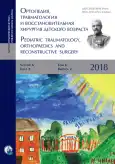Analytical revisit to basics helps reduce unnecessary CT scan in children with abdominal trauma: A single institution experience
- 作者: Khan R.A.1, Hazique M.1, Wahab S.1
-
隶属关系:
- JNMCH, AMU
- 期: 卷 6, 编号 2 (2018)
- 页面: 54-62
- 栏目: Original papers
- URL: https://bakhtiniada.ru/turner/article/view/8990
- DOI: https://doi.org/10.17816/PTORS6254-62
- ID: 8990
如何引用文章
详细
Introduction. CT scan is regarded as the investigation choice for accurate depiction of blunt abdominal injuries in children and is considered as an inevitable tool in the armamentarium of the clinician before deciding for conservative management of these children. However over dependence on CT scan puts the patient to many disadvantages.
The aim of this study to devise stratification criteria for the children with blunt abdominal injury and advise CT scan to the children only who really require it.
Material and methods. All the children with blunt abdominal injury were studied prospectively over a period of two years. These children underwent clinical, biochemical and ultrasonographic assessment at presentation followed by CT abdomen. Efficacy of predefined clinical, biochemical and ultrasonographic parameters was compared with CT scan to triage the children with intra abdominal injury.
Results. A total of 84 children were registered in the study based on final diagnosis of presence or absence of intra abdominal injury the children were divided in two groups. These groups were then compared for various clinical, laboratory and ultrasonographic parameters to predict intra abdominal injury. The children having isolated abdominal injury, tenderness, raised AST, ALT and amylase and free fluid on ultrasonography were found to have more chances of intrabdominal injury (p < 0.001). These parameters were the most sensitive parameters to predict intra abdominal injury and the cumulative sensitivity of these parameters was 99.7%. The CT abdomen was negative in 74.7% of the patients.
Conclusion. Due to high negative rate of CT abdomen in children with abdominal trauma, its use as first line imaging investigation is questionable in all the children with abdominal trauma. We suggest that by utilizing clinical, biochemical and ultrasonographic parameters, the children at risk of intra abdominal injuries can identified with almost 100% accuracy mandating the use of CT scan only in these children.
作者简介
Rizwan Khan
JNMCH, AMU
编辑信件的主要联系方式.
Email: drshaguftawahab@rediffmail.com
MS, MCh, Associate Professor, Department of Pediatric Surgery
印度, AligarhMohd Hazique
JNMCH, AMU
Email: drshaguftawahab@rediffmail.com
MBBS Resident, Department of Radiodiagnosis
印度, AligarhShagufta Wahab
JNMCH, AMU
Email: drshaguftawahab@rediffmail.com
MD, Associate Professor, Department of Radiodiagnosis
印度, Aligarh参考
- Holmes JF, Lillis K, Monroe D, et al. Identifying children at very low risk of clinically important blunt abdominal injuries. Ann Emerg Med. 2013;62(2):107-116. doi: 10.1016/j.annemergmed.2012.11.009.
- Farach SM, Danielson PD, Amankwah EK, Chandler NM. Repeat computed tomography scans after pediatric trauma: results of an institutional effort to minimize radiation exposure. Pediatr Surg Int. 2015;31(11):1027-1033. doi: 10.1007/s00383-015-3757-1.
- Gaines BA. Intra-abdominal solid organ injury in children: diagnosis and treatment. J Trauma. 2009;67(2 Suppl):S135-139. doi: 10.1097/TA.0b013e3181adc17a.
- Hom J. The risk of intra-abdominal injuries in pediatric patients with stable blunt abdominal trauma and negative abdominal computed tomography. Acad Emerg Med. 2010;17(5):469-475. doi: 10.1111/j.1553-2712.2010.00737.x.
- Brenner D, Elliston C, Hall E, Berdon W. Estimated risks of radiation-induced fatal cancer from pediatric CT. AJR Am J Roentgenol. 2001;176(2):289-296. doi: 10.2214/ajr.176.2.1760289.
- Frush DP, Donnelly LF, Rosen NS. Computed tomography and radiation risks: what pediatric health care providers should know. Pediatrics. 2003;112(4):951-957. doi: 10.1542/peds.112.4.951.
- Gaines BA, Ford HR. Abdominal and pelvic trauma in children. Crit Care Med. 2002;30(11 Suppl):S416-423. doi: 10.1097/00003246-200211001-00006.
- Peters E, LoSasso B, Foley J, et al. Blunt bowel and mesenteric injuries in children: Do nonspecific computed tomography findings reliably identify these injuries? Pediatr Crit Care Med. 2006;7(6):551-556. doi: 10.1097/01.PCC.0000244428.31624.AB.
- Cotton BA, Beckert BW, Smith MK, Burd RS. The utility of clinical and laboratory data for predicting intraabdominal injury among children. J Trauma. 2004;56(5):1068-1074; discussion 1074-1065. doi: 10.1097/01.TA.0000082153.38386.20.
- Karam O, Sanchez O, Chardot C, La Scala G. Blunt abdominal trauma in children: a score to predict the absence of organ injury. J Pediatr. 2009;154(6):912-917. doi: 10.1016/j.jpeds.2009.01.001.
- Streck CJ, Jr., Jewett BM, Wahlquist AH, et al. Evaluation for intra-abdominal injury in children after blunt torso trauma: can we reduce unnecessary abdominal computed tomography by utilizing a clinical prediction model? J Trauma Acute Care Surg. 2012;73(2):371-376; discussion 376. doi: 10.1097/TA.0b013e31825840ab.
- Poletti PA, Mirvis SE, Shanmuganathan K, et al. Blunt abdominal trauma patients: can organ injury be excluded without performing computed tomography? J Trauma. 2004;57(5):1072-1081. doi: 10.1097/01.TA.0000092680.73274.E1.
- Allen CJ, Tashiro J, Sola JE. Role of FAST or Abdominal Ultrasound to Limit CT Imaging in Evaluation of the Pediatric Abdominal Trauma Patient. Curr Surg Rep. 2014;2(6). doi: 10.1007/s40137-014-0056-z.
- Sola JE, Cheung MC, Yang R, et al. Pediatric FAST and elevated liver transaminases: An effective screening tool in blunt abdominal trauma. J Surg Res. 2009;157(1):103-107. doi: 10.1016/j.jss.2009.03.058.
- Takishima T, Sugimoto K, Hirata M, et al. Serum amylase level on admission in the diagnosis of blunt injury to the pancreas: its significance and limitations. Ann Surg. 1997;226(1):70-76. doi: 10.1097/00000658-199707000-00010.
- Retzlaff T, Hirsch W, Till H, Rolle U. Is sonography reliable for the diagnosis of pediatric blunt abdominal trauma? J Pediatr Surg. 2010;45(5):912-915. doi: 10.1016/j.jpedsurg.2010.02.020.
- Scaife ER, Rollins MD, Barnhart DC, et al. The role of focused abdominal sonography for trauma (FAST) in pediatric trauma evaluation. J Pediatr Surg. 2013;48(6):1377-1383. doi: 10.1016/j.jpedsurg.2013.03.038.
- Kessler DO. Abdominal Ultrasound for Pediatric Blunt Trauma. JAMA. 2017;317(22):2283. doi: 10.1001/jama.2017.6163.
补充文件







